All Images
News Release 03-037
Liberty Bell Passes Stress Test
This material is available primarily for archival purposes. Telephone numbers or other contact information may be out of date; please see current contact information at media contacts.
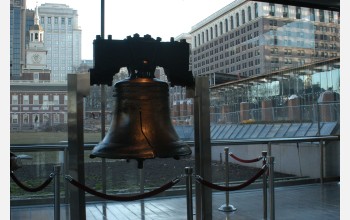
The Liberty Bell in its current pavilion located on Market Street in Philadelphia, Pennsylvania. Independence Hall is visible in the background on the left.
Credit: Curt Suplee, National Science Foundation
Download the high-resolution JPG version of the image. (431 KB)
Use your mouse to right-click (Mac users may need to Ctrl-click) the link above and choose the option that will save the file or target to your computer.
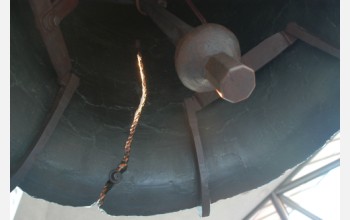
A view of the famous crack as viewed from within the Liberty Bell. The crack was originally a hairline, and by the 1840s it was a threat to the bell. In an attempt to repair the crack, part of it was drilled out (creating the widened, visible crack familiar to visitors) and rivets were inserted to hold the two sides of the fissure together. Unfortunately, the "repair" also deadened the sound, and the Bell can no longer ring. Also visible within the Liberty Bell is the spider, a structural brace that helps the Bell support its own weight-much like a flying buttress helps distribute weight away from a cathedral roof. Without the spider, the fractured Bell might collapse on itself.
Credit: Curt Suplee, National Science Foundation
Download the high-resolution JPG version of the image. (213 KB)
Use your mouse to right-click (Mac users may need to Ctrl-click) the link above and choose the option that will save the file or target to your computer.
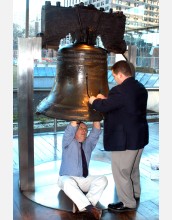
Andrew Lins (sitting), chief conservator of the Philadelphia Museum of Art and metals conservation consultant to the National Park Service on preserving the Liberty Bell, worked with MicroStrain's Steven Mundell to carefully clamp sensor devices to the icon.
Credit: Curt Suplee, National Science Foundation
Download the high-resolution JPG version of the image. (529 KB)
Use your mouse to right-click (Mac users may need to Ctrl-click) the link above and choose the option that will save the file or target to your computer.
The Liberty Bell Video, Segment 1: Attaching Sensors
Credit: National Science Foundation
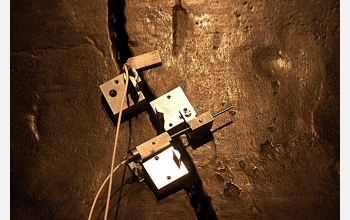
A close-up view of the MicroStrain NANO-DVRT wireless sensors clamped to the Liberty Bell (the top and bottom sensors are the same design, but oriented perpendicular to each other). With even tiny motions of the crack-on the scale of millionths of a meter-the metal rod shifts its placement. The movement is detected by electrical coils, and that information is transmitted to a wireless receiver. The wires visible in this image are connecting the sensors to a wireless transmitter inside the Bell.
Credit: Curt Suplee, National Science Foundation
Download the high-resolution JPG version of the image. (700 KB)
Use your mouse to right-click (Mac users may need to Ctrl-click) the link above and choose the option that will save the file or target to your computer.
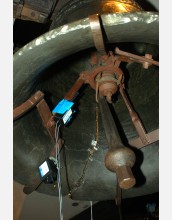
A close-up view of the spider, a structural brace that helps the Bell support its own weight. Also visible is the wireless transmitter that conveys the signals from the sensors on the crack to the computer that is recording the stresses (black box on top in blue tape) and a MicroStrain G-link sensor that detects rocking motion (black box near lip of Bell).
Credit: Curt Suplee, National Science Foundation
Download the high-resolution JPG version of the image. (412 KB)
Use your mouse to right-click (Mac users may need to Ctrl-click) the link above and choose the option that will save the file or target to your computer.
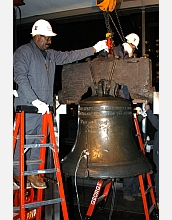
Riggers from the George Young Co. carefully position tackle that will be used to hoist the Liberty Bell.
Credit: Curt Suplee, National Science Foundation
Download the high-resolution JPG version of the image. (494 KB)
Use your mouse to right-click (Mac users may need to Ctrl-click) the link above and choose the option that will save the file or target to your computer.
The Liberty Bell Video, Segment 2: "Riggers Prepare for Lifting"
Credit: National Science Foundation
The Libery Bell Video, Segment 3: "Lifting the Liberty Bell"
Credit: National Science Foundation
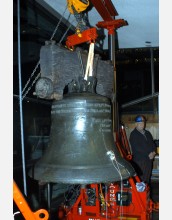
The Liberty Bell hangs after being hoisted out of its supports. Visible are the straps that hold the Bell, with protective padding separating the strap fabric and the Bell metal.
Credit: Curt Suplee, National Science Foundation
Download the high-resolution JPG version of the image. (491 KB)
Use your mouse to right-click (Mac users may need to Ctrl-click) the link above and choose the option that will save the file or target to your computer.
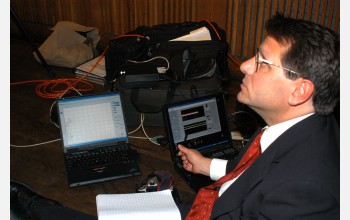
MicroStrain president Steve Arms monitors the incoming stream of sensor data as the Bell is lifted.
Credit: Curt Suplee, National Science Foundation
Download the high-resolution JPG version of the image. (393 KB)
Use your mouse to right-click (Mac users may need to Ctrl-click) the link above and choose the option that will save the file or target to your computer.
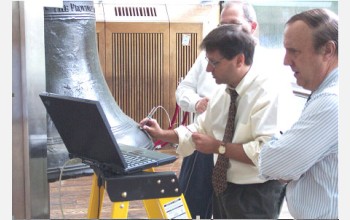
Steve Arms conducts initial measurements on the Liberty Bell.
Credit: MicroStrain, Inc.
Download the high-resolution JPG version of the image. (43 KB)
Use your mouse to right-click (Mac users may need to Ctrl-click) the link above and choose the option that will save the file or target to your computer.
The Liberty Bell Video, Segment 4: "Comments from Steve Arms, President, MicroStrain, Inc."
Credit: National Science Foundation
The Liberty Bell Video, Segment 5: "Comments from Karie Diethorn, Supervisory Museum Curator at Independence National Historical Park in Philadephia."
Credit: National Science Foundation
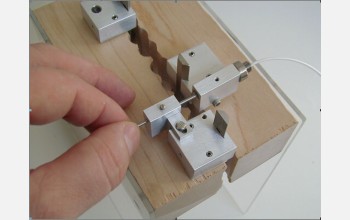
A wooden model of the Liberty Bell crack which the researchers at MicroStrain used to design their custom sensor mounts.
Credit: MicroStrain, Inc.
Download the high-resolution JPG version of the image. (52 KB)
Use your mouse to right-click (Mac users may need to Ctrl-click) the link above and choose the option that will save the file or target to your computer.


